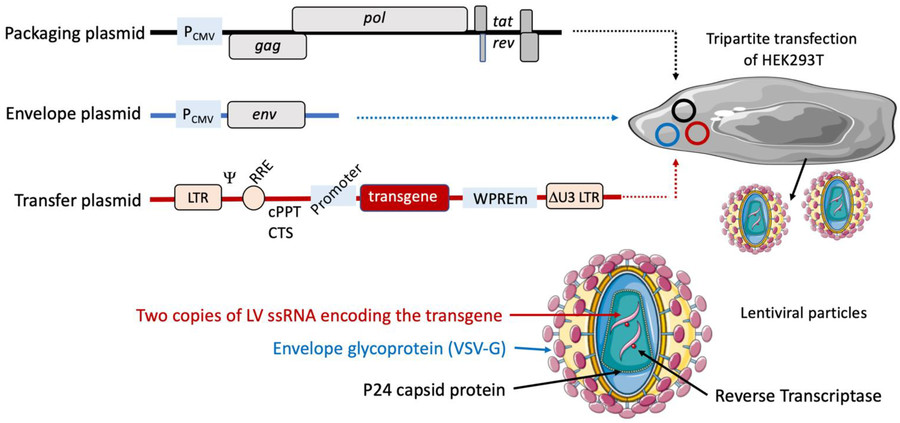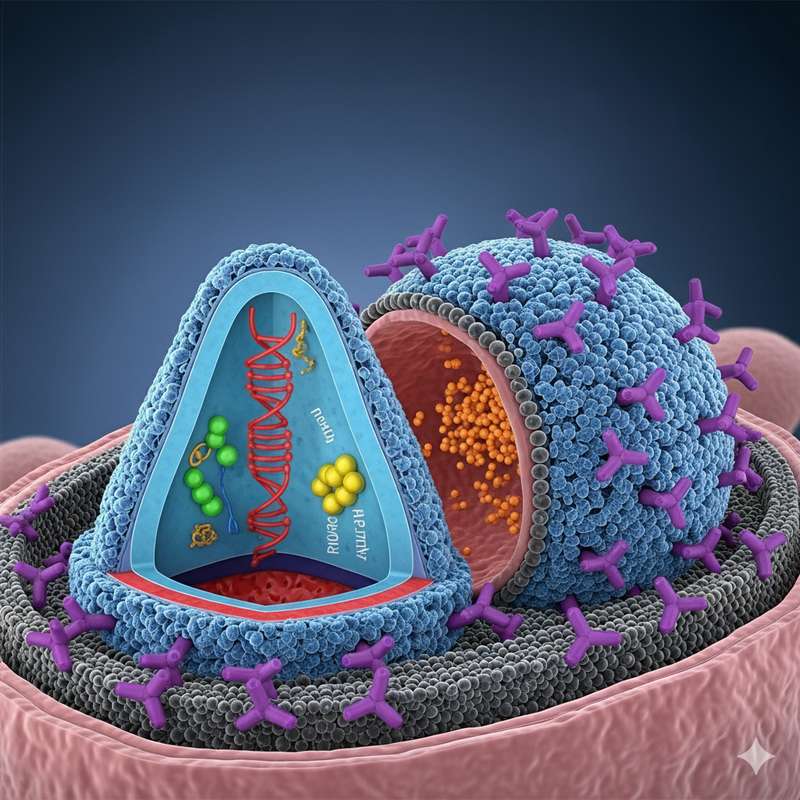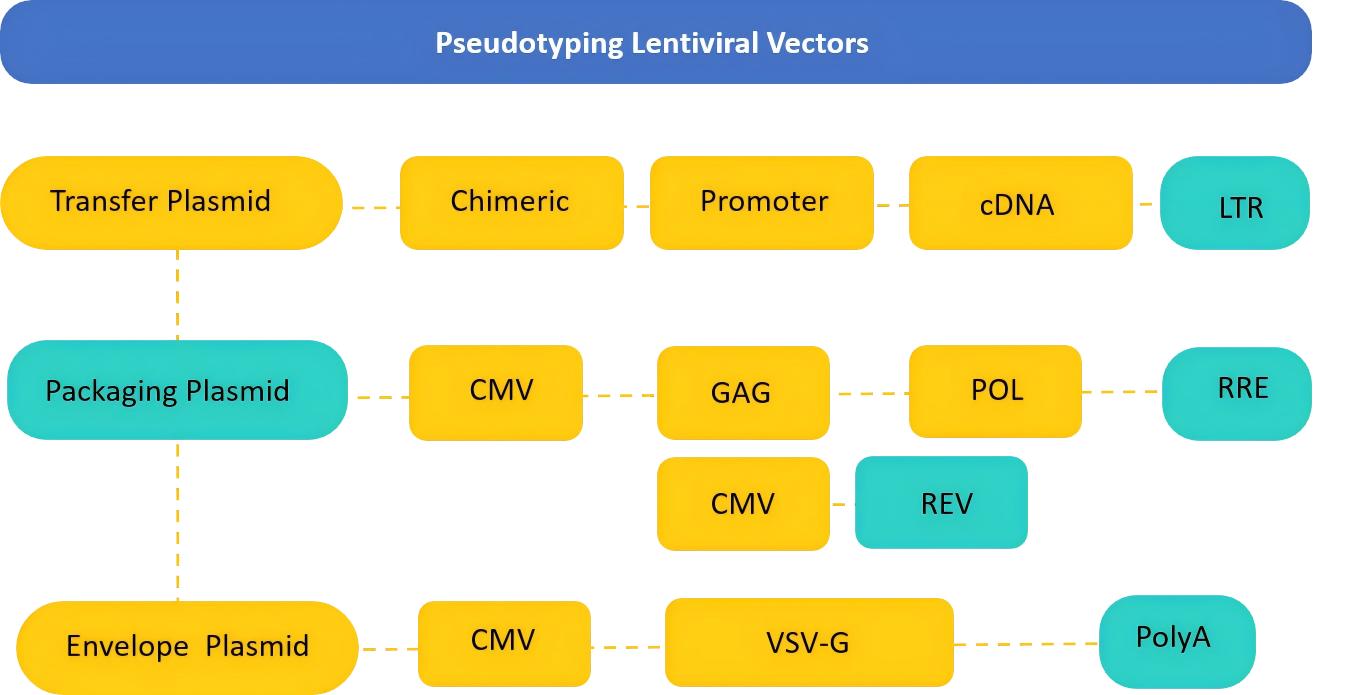Glycoprotein Optimization of Lentiviral Vector
If you are looking for more control over the cell types infected by lentiviral vectors, pseudotyping may be helpful. In pseudotyping, you use the viral envelope protein of another virus to generate a viral vector that limits or expands the host cell range (tendency). Pseudotyping is only performed on enveloped viruses such as lentivirus, retrovirus, and rabies virus. As a world-leading service provider in lentiviral vector services, Creative Biolabs is passionate about offering valuable solutions to develop promising lentiviral vector-based services for our clients.
Overview of Lentiviral Vectors
The lentiviral vector is derived from the human immunodeficiency virus (HIV), but after engineering modifications, its replication ability is insufficient to ensure biological safety. Vector systems typically consist of multiple plasmids to prevent the production of replication capable lentiviruses (RCLs) through homologous recombination. The core components of lentiviral particles are:
- Transfer Plasmid: Contains the transgenic of interest, flanked by long terminal repeat (LTR) sequences and other cis acting elements required for packaging and integration.
- Packaging Plasmid: Encoding viral structural proteins (Gag, Pol) and regulatory proteins (Rev) required for vector assembly.
- Envelope Plasmid: The gene that provides the envelope glycoprotein, which is a key component of the viral envelope. This protein determines the orientation of the carrier.
 Figure 1 Lentiviral plasmids and the principle of production of lentiviral vectors.1
Figure 1 Lentiviral plasmids and the principle of production of lentiviral vectors.1
Pseudotyping Lentiviral Vectors

In recent years, many scientists have focused on discovering novel therapeutic vectors which have a specific or large cell transfection range. As a consequence, a wide variety of lentiviral vectors have been generated using envelope proteins from different species or engineered proteins. For instance, lentiviral vectors can be pseudotyped with a series of glycoproteins, such as glycoprotein G from vesicular stomatitis virus (VSV-G). The results suggest that pseudotyping is a significant method for producing various lentiviral vectors by different types of envelope proteins. To date, pseudotyping has been widely used for studying cell receptors, virus intrusion, as well as unknown or highly pathogenic viruses.
Why Need Pseudotype?
Slow viruses and retroviruses typically target immune cells with their wild-type envelope. However, pseudotyping allows these viruses to infect neurons. In addition to altering the host inclination of the virus, there are many other reasons that may lead to viral pseudotyping:
Lowering Cytotoxicity - Different envelope proteins have varying degrees of cytotoxicity, and the mechanisms behind cytotoxicity may differ. For example, the popular VSV-G envelope protein can cause infected cells to fuse together, forming syncytia and leading to cell death. Cytotoxicity may also be cell type dependent: if a cell has fewer receptors for a specific envelope protein, it absorbs less virus and is less affected.
Altering Sensitivity to Serum - Different pseudoviruses are inactivated to varying degrees in serum by non-specific complement mechanisms. Sometimes, this is due to cells produced by viral vectors. For example, vesicular stomatitis virus, HIV-2 and human foam virus produced in cell lines expressing galactosyl galactose sugar are less stable than those produced in cell lines that do not express these sugars. Regardless of the type of cell being produced, the VSV-G envelope protein is inactivated by serum, but other envelopes, such as the envelope of gibbon leukemia virus (GALV), are more stable.
Studying a Viral Pathogen More Safely - Recently, many researchers of severe acute respiratory syndrome coronavirus type 2 have begun pseudotyping the spike protein of severe acute respiratory syndrome coronavirus 2 as a lower BSL virus like lentivirus. In this way, they can study the role of spike proteins in infected cell lines without using the complete severe acute respiratory syndrome coronavirus type 2 virus.
What Creative Biolabs Offers?
Creative Biolabs offers a large selection of lentiviral vector-based services, ranging from lentiviral vector construction, lentiviral expression, lentiviral cloning, lentiviral packaging to glycoprotein optimization. Thus far, we have successfully pseudotyped an HIV-based lentiviral vector using the envelope proteins of measles virus (MV). The cytoplasmic tails of MV proteins, including the fusion protein, have been truncated and CD46 has been regarded as a receptor for identifying MV tropism. Furthermore, we also provide the envelope protein assessment services for pseudotyping of lentiviral vectors. For instance, more recent studies conducted by our labs have evaluated the ability of many lentiviral vectors to infect a variety of host cells. Additionally, we have classified our pseudotyping services into five groups basing on the cell types, including but not limited to:
How to Pseudotype?
To pseudotype the viral vector, you used the same protocol to generate the lentivirus, but you used a different envelope glycoprotein instead of the wild-type glycoprotein. Pseudotype proteins are encoded on enveloped plasmids containing promoters, envelope genes, and polyA tails.
 Figure 2 Lentiviral production involves the use of three plasmids.
Figure 2 Lentiviral production involves the use of three plasmids.
Frequently Asked Questions
Q: What are the main advantages of pseudo typing of lentiviral vectors?
A: The main advantage is the ability to precisely control the orientation of the carrier. This allows for the delivery of targeted genes to specific cell types, which is essential for both in vivo gene therapy and in vitro cell specificity research, thereby reducing off target effects and improving efficacy.
Q: Is pseudotyping with VSV-G always the best option?
A: Although VSV-G has become a widely used pseudotype due to its broad tendency and stability, it is not always the best choice. For applications that require specific targeting of specific tissues (such as neurons) or cell types (such as T cells), different, more specific pseudotypes (such as RabV-g or measles virus glycoprotein) would be more suitable.
Q: What is the difference between pseudotyped lentiviral vectors and native lentiviral vectors?
A: Natural lentiviral vectors use viral Env (such as HIV-1 gp120) to enter, limiting their affinity to CD4+cells and increasing immunogenicity. The pseudovector replaces natural Env with heterologous glycoproteins (such as VSV-g, RD114) to expand tropism, enhance stability, and reduce immunogenicity.
Q: Can you develop a custom pseudotype for a new virus?
A: Yes, it is. Our expert team has extensive experience in gene design and cloning. We can collaborate with you to design, synthesize, and optimize a novel envelope glycoprotein based on your specific research needs, and then produce corresponding pseudo lentiviral vectors.
Q: Which glycoprotein should I choose for my target cell/tissue?
A: The choice depends on your goals:
- Widely oriented (most cells): VSV-G (stable, freeze-thaw resistant).
- T cells/HSC: RD114 or GALV (targeting PiT-1 receptor).
- Neuron: RV-G (targeting NCAM/p75NTR).
- Liver: Modified Sindbis Env (targeting ASGPR).
Drop Us a Line Today!
To help our clients develop a safe and effective lentiviral vector, Creative Biolabs is continuously exploring novel technologies to provide broadly applicable pseudotyping services targeting a wide range of cell types. Moreover, we are committed to exploring modifications to the lentiviral vector-based technology for better applications. If you are interested in our services, please feel free to contact us for closer communication to learn how we can be involved in your project. Separate services or integrated end-to-end solutions are all welcomed.
Reference
- Taghdiri M, Mussolino C. Viral and non-viral systems to deliver gene therapeutics to clinical targets. International Journal of Molecular Sciences, 2024, 25(13): 7333. https://doi.org/10.3390/ijms25137333 (Distributed under Open Access license CC BY 4.0, without modification.)





